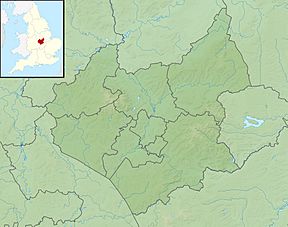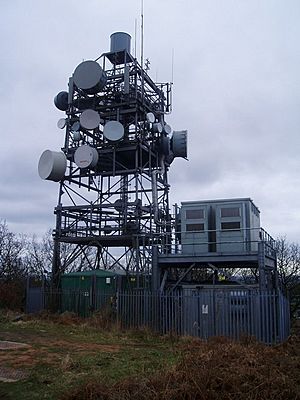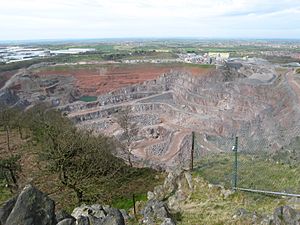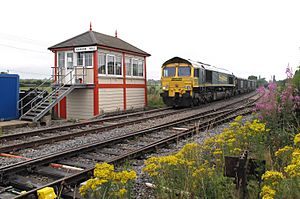Bardon Hill facts for kids
Quick facts for kids Bardon Hill |
|
|---|---|
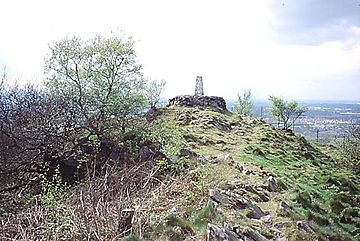 |
|
| Highest point | |
| Elevation | 278 m (912 ft) |
| Prominence | 172 m (564 ft) |
| Listing | Marilyn, HuMP, TuMP (200-299m), Historic County Top, Current County/UA Top, Administrative County Top, Clem (Ma,Hu,Tu,2,CoH,CoU,CoA,Cm)(Tu,4,Cm) |
| Geography | |
| Location | Bardon, Leicestershire, England |
| OS grid | SK 459131 |
| Topo map | OS (1:50k) 119 (1:25k) OL24W |
| Site of Special Scientific Interest | |
 |
|
| Area of Search | Leicestershire |
|---|---|
| Interest | Biological |
| Area | 13.1 hectares |
| Notification | 1983 |
Bardon Hill is the highest point in Leicestershire, England. On a clear day, you can see far-off places like the Malvern Hills and Shropshire Hills, which are about 50-60 miles away. You might also spot peaks in Derbyshire (30-40 miles away) and even Lincoln Cathedral, nearly 50 miles distant.
Bardon Hill is also a special place for nature. It is a 13.1-hectare (32-acre) biological Site of Special Scientific Interest (SSSI). This means it's protected because of its important plants and animals. The hill is found near Coalville in Leicestershire.
Contents
What is Bardon Hill?
Bardon Hill is actually what's left of an old volcano. It stands 278 m (912 ft) above sea level, making it the highest point in both Leicestershire and the National Forest. Because it's so tall, you can see it from many miles away.
Right next to Bardon Hill is the Bardon Hill Quarry. This is another special site for geology. At the very top of Bardon Hill, you'll find a trigonometrical point (a marker used for mapping) and a large radio mast. The second highest hill in Leicestershire is Beacon Hill, which is nearby.
The name "Bardon Hill" also used to refer to a village that was located southwest of the hill. Most of that village was taken down. However, the name "Bardon Hill" is still used as the postal address for the homes that remain there.
Radio Masts on the Hill
There are two radio masts near the top of Bardon Hill. The smaller mast was first built for the BBC. It helped link outside broadcasts to the Sutton Coldfield Transmitter. Later, this equipment was moved to the larger mast.
The larger mast was originally built by an electricity company. Today, it is owned by Cellnex, which bought it from Arqiva in 2019. This mast helps provide the NOW Leicester DAB radio service.
People have always loved the views from Bardon Hill. In the 1830s, a writer named John Curtis said you could see over 5,000 square miles (13,000 km2) from the top. That's about one-twelfth of England and Wales! Another writer, Potter, said the view from Bardon Hill "probably commands a greater extent of surface than any other point of view on the island." He even called it "one of the most extraordinary points of view in Nature." Because of these amazing views, telecommunication companies have built large transmitters and radio masts there.
Nature and Wildlife
Bardon Hill is a small part of what was once a huge forest called Charnwood Forest. It has both woodlands and open heathland. On the lower parts of the hill, you'll find many old oak trees. Higher up, there are pine trees, along with heath, grassy areas, rocky spots, and scrub oak.
The hill is famous for its many types of lichens (small plant-like growths) and invertebrates (animals without backbones), especially spiders. Scientists have found 133 different kinds of spiders here, including a rare one called Tetrilus macrophthalmus.
Hill's Geology
Bardon Hill is made of very old volcanic rocks. These rocks are part of something called the Bardon Hill Volcanic Complex. This volcanic complex is thought to be similar to the Soufrière Hills volcano on the island of Montserrat in the Caribbean.
The hill and the land around it are made of igneous and volcanic rocks. These rocks formed about 600 million years ago, in the precambrian age. The areas around the hill are covered with a mix of boulder clay and Mercia mudstone.
The Quarry at Bardon Hill
People have been digging for granite at Bardon Hill for a very long time. The first mention of a quarry here was in 1622. A small quarry appeared on maps in 1835, but large-scale digging began in 1857.
The quarry grew thanks to local families and the opening of the Leicester and Swannington Railway. This railway passed close to Bardon Hill. A short branch line was built so that stone from the quarry could be easily moved onto the railway network.
The quarry is now owned by Aggregate Industries. It is one of their five "Super-Quarries" in the UK and serves as their main office. In 2009, the company asked for permission to make the quarry much bigger. This would allow them to dig for another 40 years. After the quarry is finished, the company plans to fill in parts of the site and turn it into a nature area.
A Royal Visit
In 1840, Queen Adelaide, who was the Queen Dowager (the mother of the future king), visited Bardon Hill. She chose the area, which was then a deer park, for a picnic.
A writer named T. R. Potter described the visit. Queen Adelaide, along with her sister and other important people, climbed the steep hill easily. They spent over an hour at the top, enjoying the amazing view. The Queen often said how much she admired the scenery.
For their picnic, the Queen's food was first laid out on the grass. But because the sun was too strong, she decided to move to a shadier spot. She even picked up the first dish herself, and everyone else followed, carrying parts of the meal. The place where the Queen chose to have her picnic has since been named "Adelaide's Bower."
Bardon Park and Hall
Bardon Park was a large medieval deer park, covering about 1200 acres. Bardon Hill and Bardon Hall were both inside this park. It's believed that the area became a deer park before the year 1300.
Today, you can still find deer in Bardon Park, along with foxes and badgers. There are also birds like buzzards, peregrine falcons, ravens, and barn owls living there.
Bardon Hall
The original Bardon Hall was a house surrounded by a moat, located in a valley south of Bardon Hill. In the 1830s, a new hall was built halfway up the hillside. This new hall is a grand home with great views over the parkland. The old hall was taken down around the time the new one was built, but its moat still remains.
The current Bardon Hall is a Grade II Listed building, meaning it's historically important. It is now the main office for Aggregate Industries, the company that owns the Bardon Hill Quarry. For many years, Bardon Hall was home to the Hood family.
Bardon Park Chapel
In the 1690s, John Hood, who owned Bardon Hill and Bardon Park, built a Christian meeting house. This building is thought to be the oldest Non-conformist place of worship in Leicestershire and the wider East Midlands.
The year "1877" is carved above the door, which is when the building was updated. However, the main structure of the building dates back to the 1690s. It was originally known as "Bardon Meetinghouse" and is now called Bardon Park Chapel.
Bardon Village and Schools
During the 1800s, a village of quarry workers' cottages was built southwest of Bardon Hill. This village, called Bardon, had the postal address "Bardon Hill." The cottages were very close to the quarry and were taken down around 1988.
There have been three school buildings in Bardon. In the 1800s, there was a "British School" day-school behind Bardon Park Chapel. This was in addition to a Sunday school that started in 1820.
Later, another day-school was built within the row of quarry workers' cottages. This school then moved to a new building nearby. The schoolhouse in the cottages no longer exists. The second school building is still standing and is used as offices and a laboratory for Aggregate Industries.
Parish Church
The Church of England parish church of Saint Peter was built in 1899. It is located near the main A511 road. It used to have its own vicar but is now part of a group of churches with Christ Church, Coalville, and St. Michael and All Angels, Ravenstone.
Images for kids


